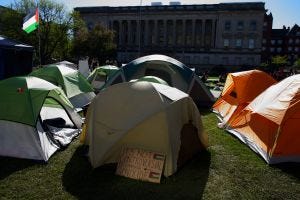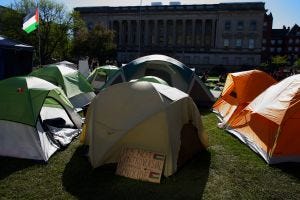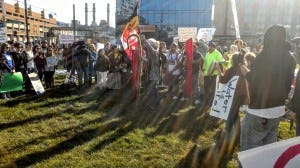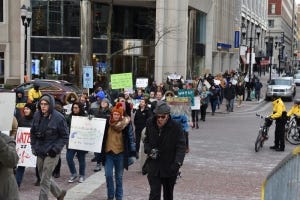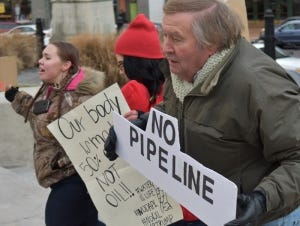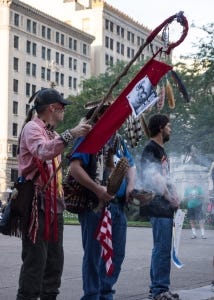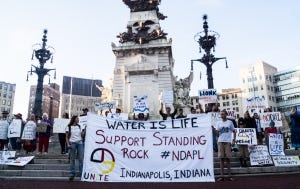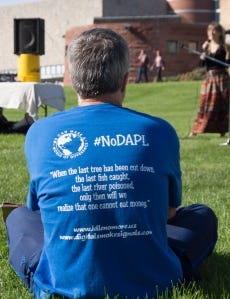Protest Rights at Stake
It’s interesting to see a variety of stories recently about numerous acts of protest. Protest rights really are at stake, especially in these days of increasing authoritarianism.
I recently wrote about the years of protest and struggle by the Wet’suwet’en peoples in British Columbia against the Coastal GasLink pipeline.
(See: Indigenous Land Defenders).
Greenpeace
Today, a civil trial against Greenpeace begins. As the article says, “protest rights are at stake as pipeline company brings Greenpeace to trial.”
A civil trial commences on February 24 that will determine whether Greenpeace must pay $300 million in damages to Energy Transfer Partners, the corporation behind the Dakota Access Pipeline (DAPL). The lawsuit alleges that Greenpeace “incited” and masterminded the NoDAPL Water Protectors uprising of 2016-2017, in which thousands of Indigenous people and allies gathered on Standing Rock Sioux lands to protest DAPL construction. On the basis of a legally circumspect theory of collective liability, the lawsuit seeks financial compensation for crimes committed by protesters, as well as damages for business relationships frayed by a successful divestment campaign directed at DAPL investors.
In 2016, protests began against DAPL, a pipeline slated to ferry fracked oil underneath a fragile water crossing a mere half mile north of the Standing Rock Sioux Nation. Using tactics ranging from confrontational demonstrations to divestment campaigns, protesters stalled construction, forced environmental reevaluation of the permit and caused investors to pull out of the project. Although Donald Trump approved the pipeline during his first administration in 2017, the movement successfully delayed construction and increased the cost of the project.
Protest Rights Are at Stake as Pipeline Company Brings Greenpeace to Trial. Greenpeace faces a $300 million lawsuit from Energy Transfer Partners, the company behind the Dakota Access Pipeline by Cody Bloomfield, Truthout, February 23, 2025
Nonviolent protest is supposed to be protected by the First Amendment of the U.S. Constitution. Which is different from civil disobedience, where a law is intentionally broken to bring attention to what is considered an injustice by those who are protesting. I acted in civil disobedience when I was a draft resister during the Vietnam War.
Since the October 7, 2023 attack on Israel, the Israeli Defense Forces (IDF) have relentlessly attacked the Palestinians living in Gaza. In response, there has been global pro-Palestinian support.
In the U.S. this has shown up most publicly at the student solidarity camps, where students’ first amendment rights were commonly disregarded, and significant punishments were inflicted. I visited and wrote about the student solidarity camp at the University of Wisconsin here in Madison.
(See: https://unflinching.blog/?s=gaza+Palestine)
“Inciting Protest”
In 2016, when Greenpeace received word that Indigenous groups at Standing Rock needed outside support, the organization put boots on the ground in North Dakota. Greenpeace supported the Indigenous People’s Power Project, a nonprofit group that teaches protesters nonviolent direct action tactics.
“We were working to empower others to teach and share skills, particularly around deescalation. Nonviolence is something we care deeply about, and we believed in supporting that,” Deepa Padmanabha, senior legal advisor to Greenpeace, told Truthout.
Conscious of the history of environmental movements ignoring Indigenous activism, Greenpeace sought out the opportunity to play a support role in the NoDAPL fight.
“Big Greens have a problematic history of white supremacy, patriarchy, all of the things,” Padmanabha said, using the term “Big Greens” to refer to large environmental advocacy nonprofits. “And this was an example of how a Big Green could actually be there in solidarity and be an ally for frontline fights led by impacted communities.”
From the point of view of Greenpeace — and many Indigenous organizers — Greenpeace showed up to provide support at a critical juncture, at the upswell of the Sacred Stone protest camp. According to the lawsuit, the direct action training covered how protesters could lock their bodies to construction equipment and form blockades.
Led by Indigenous organizers, protesters blocked roads, locked themselves to construction equipment and held mass demonstrations. At one point, the sheriff of Morton County issued orders to halt construction due to the safety hazard posed by protesters. Delays in construction bought time — time for legal cases to proceed through court, for the movement to grow and for divestment campaigns to proceed.
When police and private security responded to protests by bringing in attack dogs and injuring hundreds by blasting water cannons in subfreezing weather, NoDAPL hit international headlines. At its peak, during Thanksgiving of 2016, several thousand people occupied the Sacred Stone protest camp. Indigenous people from around the country turned out in solidarity with the Standing Rock Lakota/Dakota people. An Indigenous veteran of the 1973 Pine Ridge standoff remarked that these DAPL protests were reminiscent of the American Indian Movement uprising at Wounded Knee.
During the trial, lawyers for Energy Transfer Partners will argue that Greenpeace orchestrated the protests. Both Greenpeace and Indigenous organizers of the movement expressed outrage at the narrative woven by the pipeline company.
Protest Rights Are at Stake as Pipeline Company Brings Greenpeace to Trial. Greenpeace faces a $300 million lawsuit from Energy Transfer Partners, the company behind the Dakota Access Pipeline by Cody Bloomfield, Truthout, February 23, 2025
Congress shall make no law respecting an establishment of religion, or prohibiting the free exercise thereof; or abridging the freedom of speech, or of the press; or the right of the people peaceably to assemble, and to petition the Government for a redress of grievances.
First Amendment, US Constitution
Photo credit: Jeff Kisling
